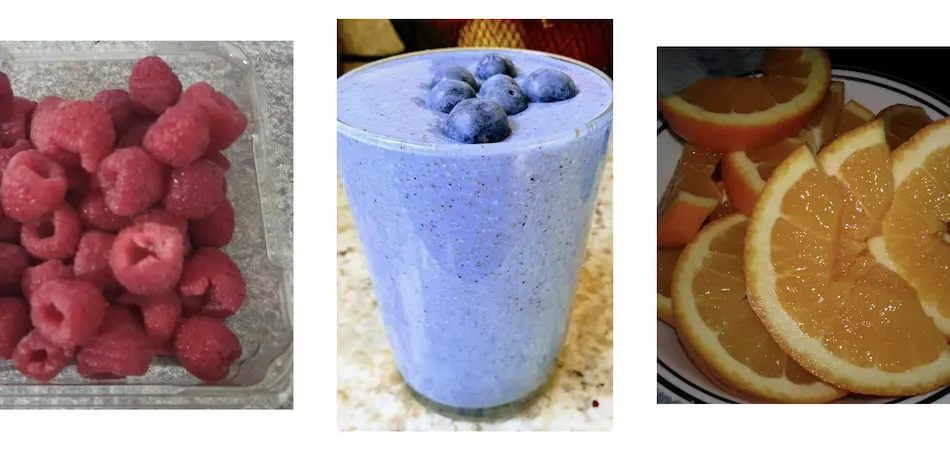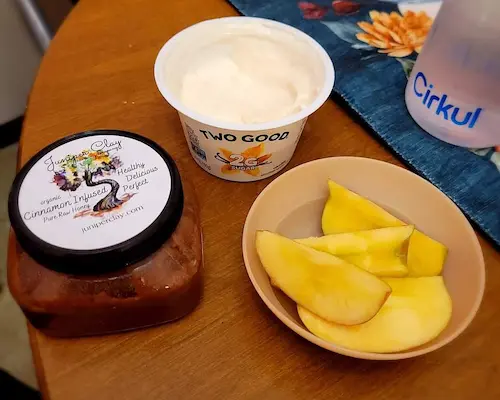Are you wondering which fruits are allowed on Optavia to maximize weight loss?
Well, while a small serving of fruits can be used as a snack in Optavia 4 and 2 Plan, or as a healthy exchange in the Optimal Health 3 and 3 Plan, they aren’t allowed on the 5 and 1 Plan.
If you’re following the Optavia 5 and 1 plan, you can start to introduce 2 medium-sized pieces of fruit from the second week of transition.
However, after living an Optavia lifestyle for over 12 months (and losing over 40 pounds) I learned how to modify my meal plan and still enjoy a variety of fruits.

First, let’s talk about fruit on the Optavia diet
According to the Optavia Diet guidelines, you should eat 6 meals per day and exclude any fruits.
Why?
One possible answer is that fruits contain a lot of simple sugars, which may cause obesity.
So, it makes sense that eating the fruit would make people gain weight instead of losing it, right?
Well, it depends.
Studies have shown that most types of fruit actually help people avoid obesity.
According to the article published in the Frontiers in Nutrition Journal, “evidence suggests that eating whole, fresh fruit is not likely to make people fat or contribute to excess energy intake.”
“This conclusion comes from studies that lasted 3-24 weeks and from long-term observational studies,” states the journal.
My experience with eating fruits on Optavia
I must admit – I used to think that eating fruit is bad because it has sugar in it.
I was hesitant to eat fruits on Optavia because I have a family history of type 2 diabetes and I didn’t want to develop the condition myself.
I was mistaken.
According to an article published in The Journal of Clinical Endocrinology and Metabolism, “people who ate fruit every day were less likely to get diabetes than people who did not eat fruit every day.”
This was true even when other things that could affect diabetes were taken into accounts, such as diet and exercise.
“Eating whole fruits, but not drinking fruit juice, may help to prevent diabetes,” states the article.
According to American Diabetes Association, “a great way to have a sweet treat and get extra nutrition is to have fruit for dessert.”
“The best choices of fruit are any that are fresh, frozen, or canned without added sugars.”
“A small piece of whole fruit or about ½ cup of frozen or canned fruit has about 15 grams of carbohydrates,” states the AHA.
I learned that I still can eat fruit, but I need to make sure to eat it in moderation.
From my experience of incorporating fruits into my Optavia meal plan, I noticed that moderation is vital.
Personally, I try to limit myself to 1-2 servings per day of a variety of fruits while avoiding fruit juice in favor of whole fruit for the best results.
What fruits are allowed on Optavia?
Although Optavia doesn’t provide a comprehensive list of fruits allowed on the 4 and 2 plan, choosing the fruits that are lower in glycemic index is your best bet.
According to the British National Health Service (NHS), the glycemic index (GI) is a way of measuring how quickly a food raises blood sugar levels.
“Fruits with a high GI are absorbed and digested quickly, which causes blood sugar to rise quickly.”
On the other hand, “fruits with a low GI are absorbed and digested more slowly, so blood sugar levels don’t rise as fast,” states the NHS.
I quickly made the switch and chose fruits with a low GI.
Apples, pears, berries, and stone fruits like cherries and plums are ideal choices over bananas, mangos, and pineapples.
Making this simple switch has not only improved the overall nutritional value of my meals but also allowed me to feel more productive with stable energy levels.
Optavia fruit guide
Apart from choosing low GI fruits, there are several ways you can start enjoying fruits on the Optavia diet.
Whenever you’re looking for healthy snack options or you want to create your own Optavia fuelings from the scratch, these tips allowed me to lose over 40 pounds in a short period of time.
I want to share what I learned so others can make changes too.
1. Avoid (or limit high GI fruits)
Here are some examples of high-GI fruits that if eaten in excess may increase your sugar levels and throw you out of the fat-burning state on Optavia:
- Watermelon
- Pineapple
- Mango
- Papaya
- Cantaloupe
- Honeydew melon
2. Limit dried fruit
Even if the label claims that it’s unsweetened, dried fruits can have high glycemic indexes.
This may lead to weight gain and offer no additional nutritional value compared with their fresher counterparts.
To stay health-focused, I try to limit my consumption of dried fruits.
I may add some to my Optavia shakes to make them taste better or sprinkle a few on top of my salads for an extra flavor punch.
3. Eat fruits with protein or fat
Nutrition Research and Practice Journal state that “mixing different foods together, the protein and dietary fiber can have a big effect on the glycemic index. This means that it can reduce the blood glucose response.”
A great example is when I eat an apple with either a tablespoon of nut butter or cottage cheese for added protein or a small whole egg for added fat.
Here’s the photo of one of my Optavia fueling alternatives – high protein yogurt with 4 slices of apple.

This slows down the digestion of the fructose sugars in the apple and prevents my blood sugar levels from spiking too high, according to the journal.
4. Eat fruits in their whole form
As for me, I prefer to avoid juices and store-bought purees for consuming fruits since the GI is higher for these compared to whole forms of fruits.
According to the article review published in the Nutrients Journal, “natural fruit juices have a lot of sugar, just like sugar-sweetened beverages.”
Eating fruits in their whole form can be a great way for one to keep the GI down and enjoy all the nutritional benefits that come along with it.
So instead of factory-made juices or pulps, I’d recommend indulging in wholesome fruits and other diet foods for a healthy lifestyle.
5. Include fruits in your Lean and Green meals
Another way you can eat fruits on Optavia is to include them in your Lean and green meals.
When pairing fruits with non-starchy vegetables, such as lettuce, kale, bell peppers, and cucumbers, you can achieve a lower GI.
Here’s the photo of my salad for my lean and green meal.

This one in the picture has apples, avocados, tomatoes, and plenty of leafy greens.
Together, these two powerhouses pack a wallop of nutritional benefits without pushing up the glycemic index.
6. Pay attention to the serving size
When it comes to serving size, you must treat fruits just like you would treat your greens.
According to Optavia guidelines, you can have 3 servings of low-carb vegetables with your lean and green meals.
- 1 cup: collards, endive, lettuce, mustard greens, spinach, spring mix, watercress, or bok choy.
- 1/2 cup: asparagus, cabbage, cauliflower, eggplant, a fennel bulb, kale, portabella, mushrooms, summer squash, broccoli, green beans, or peppers of any kind.
One serving size of each of the listed food items has between 20 to 50 calories.
So if you choose to have fruits, you need to ensure each of your servings has no more than 50 calories.
Optavia fruits list
Here is the list of fruits you can use for your Optavia lean and green meals.
I’ve included serving sizes that match the Optavia vegetable list in terms of calories per serving.
- 1/2 cup of apples
- 1/3 cup of pears
- 1/2 cup of berries (strawberries, raspberries, blackberries)
- 1/2 cup of plums
- 1/2 cup of cherries
- 1/2 cup of peaches
- 1/2 cup of nectarines
- 1/2 cup of oranges
For example, you can use 1/2 cup of apples as 1 out of 3 servings from your green list.
I would not recommend substituting your veggies for all fruits.
In most of my lean and green meals, I only add a maximum of one piece of fruit per meal that I have a craving.
Here’s the photo of my lean and green meal box that has lettuce on one side and dried fruit on the other side.

The rest of the box is filled with cauliflower and proteins.
The bottom line
Fruits are an essential part of my diet as they provide many vital nutrients for overall health.
They are also full of fiber, which helps to keep me feeling full and satisfied for longer periods of time.
At the same time, I’m mindful of portion sizes since they contain natural sugars that may cause weight gain if I eat them in large amounts.

Thank you!